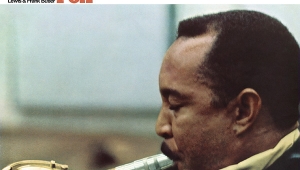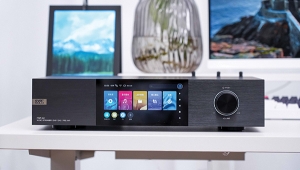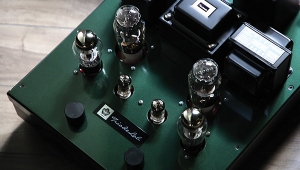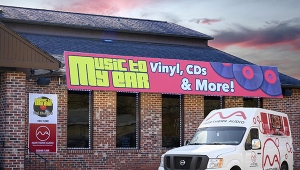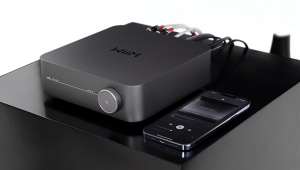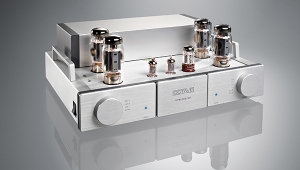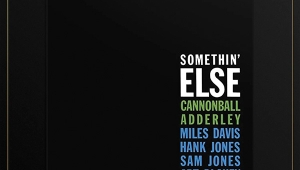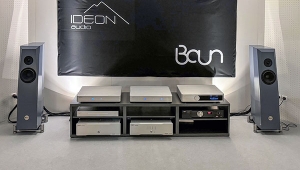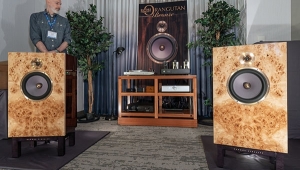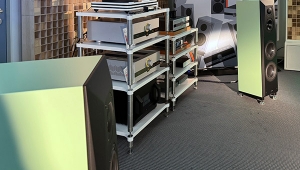| Columns Retired Columns & Blogs |
Chario Academy One loudspeaker
I first auditioned a pair of Chario Academy One minimonitors five years ago, but the review was aborted when the Italian Chario company lost its US distribution. When I reheard the Chario Academy Ones at the 1997 WCES, I found their elegant cabinetwork appealing and their sound listenable and involving. I therefore requested a pair for review from the new US importers.
 The Academy One is priced at $2300/pair, but is the least expensive model in the Chario line. Like another Italian loudspeaker manufacturer, Sonus Faber, Chario markets small, ported two-way minimonitors encased in beautiful cabinets of sculpted wood. The Academy One's solid walnut enclosure is crafted by designer Vlady Fontana and "ebonist" Michelangelo Fontana, whose signatures are engraved on the brass plate that sits behind the double set of speaker terminals (for bi-wiring). Internal wiring comes from Eagle Cable, a German company.
The Academy One is priced at $2300/pair, but is the least expensive model in the Chario line. Like another Italian loudspeaker manufacturer, Sonus Faber, Chario markets small, ported two-way minimonitors encased in beautiful cabinets of sculpted wood. The Academy One's solid walnut enclosure is crafted by designer Vlady Fontana and "ebonist" Michelangelo Fontana, whose signatures are engraved on the brass plate that sits behind the double set of speaker terminals (for bi-wiring). Internal wiring comes from Eagle Cable, a German company.
The Academy One employs a soft-dome tweeter, sourced from the Danish manufacturer Scan-Speak, and a French Focal woofer with a plastic (Neoflex) cone. The crossover is a Butterworth-derived, even-order Linkwitz-Riley type with the frequency set at 1800Hz to optimize the integration between the two drivers. Mario Murace, Chario's chief engineer, states that the Academy One's design has a moderately flat amplitude response and a uniform group delay, with some energy loss in the crossover region.
The Academy One's cabinet has rounded contours, and a small baffle that can generate even vertical and horizontal energy-radiation patterns. The 2.25"-diameter port opens to the cabinet's rear. Chario's dedicated stands for the Academy One consist of a solid 15" walnut post in matte-black finish with a natural wood accent along the side, held together with four massive bolts. The supplied Allen wrench makes assembly a snap. Unlike the Sumiko and Target stands I usually use, the Chario stands cannot be filled with sand.
Sound
The Academy Ones were placed on a variety of stands, including Chario's own 24" model ($495/pair), sand-filled Target Model R1s ($675/pair), and Sumiko's 30" "Franklin and Lowells" ($350/pair). The speakers were broken-in by playing music from an FM source for 12 hours, followed by 12 hours of the "Special Burn-In Noise Track" from Stereophile's Test CD 3.
Sweeping the Chario Academy Ones with a sinewave signal generator revealed the bass response in my living room to be good for a minimonitor. The speakers extended down to 35Hz, with peak bass output between 47 and 60Hz. The speakers' ports made a prominent chattering sound when driven hard by a 50Hz signal, but only at sustained levels far in excess of what you'd find in most music recordings.
An earlier audition with 50Wpc Woodside tube monoblocks had made it very evident that the Academy Ones need much more power, in keeping with Chario's recommended 50Wpc power minimum—the speakers had made the Woodsides clip badly on one of my rock favorites, Dan Baird's ragged vocals on Songs for the Hearing Impaired (American 26999-2). But the Academy Ones had no difficulty with the output of either the Mark Levinson No.331 or the Krell Full Power Balanced 250Ms. Switching to the 250Wpc Krells allowed the Charios to unleash their full dynamics. Most of my review was carried out with the FPB 250M amplifiers, which I would strongly recommend for this loudspeaker.
The Chario's bass response was full and strong, as heard during the opening of the "Main Title" selection from James Horner's Patriot Games soundtrack (Milan 66501-2). The mix of Maggie Boyle's soprano voice, a flute, and the ponderous 35Hz synthesizer notes were produced cleanly and distinctly, with solidity and grace. However, when the bass chords predominated, the speaker was unable to register the delicate plucked-string sequence being played at the same time. Although the Charios' overall sound was warm and sweet, it did not possess as much imaging and depth of field as did the reference speakers. The Charios' soundstage was forward, up-close, with lots of presence. Odetta's rich, deep voice on "America the Beautiful" (from Strike a Deep Chord: Blues for the Homeless on Justice) sounded powerful and warm, but the string bass, piano, and brushed drums were less distinct.
The Chario's character emerged most strongly on vocal music. Odetta's stunning rendition of "America" was smooth, warm, but diffuse through the Academy Ones, with some overloading on plosives. Don Henley's solo live performance of "Hotel California" on the Eagles' When Hell Freezes Over (Geffen GEFD-24725) was darker, chestier, more recessed than I was used to, and his acoustic guitar seemed muffled during the song's opening. The reverb added to Maggie Boyle's voice on the opening of the Patriot Games track was not as evident as I expected.
Operatic voices, too, brought out the speaker's strengths and weaknesses. The Academy One excelled with Sherrill Milnes' baritone on "Ah! Veglia, o donna, questo fiore" from Act II of Verdi's Rigoletto (London 414 269-2)—it came across as rich, glorious, and totally involving. (My notes: "This melts me like butter!") Higher-pitched voices didn't fare as well: On the same recording, Pavarotti's youthful tenor in the Duke's opening solo, "Questa o quella per me pari sona," was dynamic and rich but more compressed, lacking background spatial information.
Some of the Academy One's strong bass response was a result of a midbass and lower-midrange emphasis. This colored the sound of singers' voices. On Willie Nelson's show-stopping duet with Bonnie Raitt on "Getting Over You" (Across the Borderline, Columbia CK 52752), Raitt's voice was dark, raspy, bittersweet, and totally involving, while Nelson's was too chesty, rich, full, and "tubby." This extra resonance and coloration muted Sinead O'Connor's delicate soprano on another cut from the same album, "Don't Give Up." Her tiny, thin, threadlike voice should sound compelling, dramatically undercutting Nelson's rich baritone. The Academy One mutes her voice, leaving her words hard to discern. Even switching between the Levinson and Krell amplifiers didn't help. Harry Connick, Jr.'s rendition of "Don't Get Around Much Anymore" (from the When Harry Met Sally... soundtrack, Columbia CK 45319) was too warm, full, forward, and over-resonant. The close-miked perspective was less evident with the Academys.
What about the upper midrange and treble? The Chario reproduced flutes, bells, and cymbals with clarity, but were lacking a sense of effortless, wide-open upper registers. The Academy One's treble was more rolled-off and sweet on "A Call to Arms" from the Glory soundtrack LP (Virgin 90531 1), without the recording's transparency and sheen. Two orchestral selections on vinyl were missing a sense of the hall: the excerpts from Prokofiev's Romeo and Juliet (Leinsdorf/LAPO, Sheffield Lab 8), and Shostakovich's Symphony 6 (Stokowski/CSO, RCA LSC-3133).
Conclusions
The Chario Academy One's sculpted walnut exterior and rich finish signal "exotic, well-crafted Italian import" to the audiophile. The Academy One offers a strong bass response and a warm, smooth sound. When driven by high-powered solid-state amplification, the Chario Academy One has good dynamic range and bass impact, and is smooth and listenable. I found the Academy One's rich, lustrous, and dynamic reproduction of operatic vocal music extremely involving and magical. I recommended Richard Bonynge's 1971 version of Verdi's Rigoletto for this year's Records to Die For, for example, after playback on the Academy Ones. However, its upper registers sound less extended and are darker-balanced than those of my favorite minimonitors. It is possible that its high frequencies will sound more neutral in smaller rooms than mine, though the bass might then sound even richer. This well-engineered speaker is worth auditioning, but tall stands (30" or so high) will be mandatory if the speaker is not to sound too laid-back.
- Log in or register to post comments

















